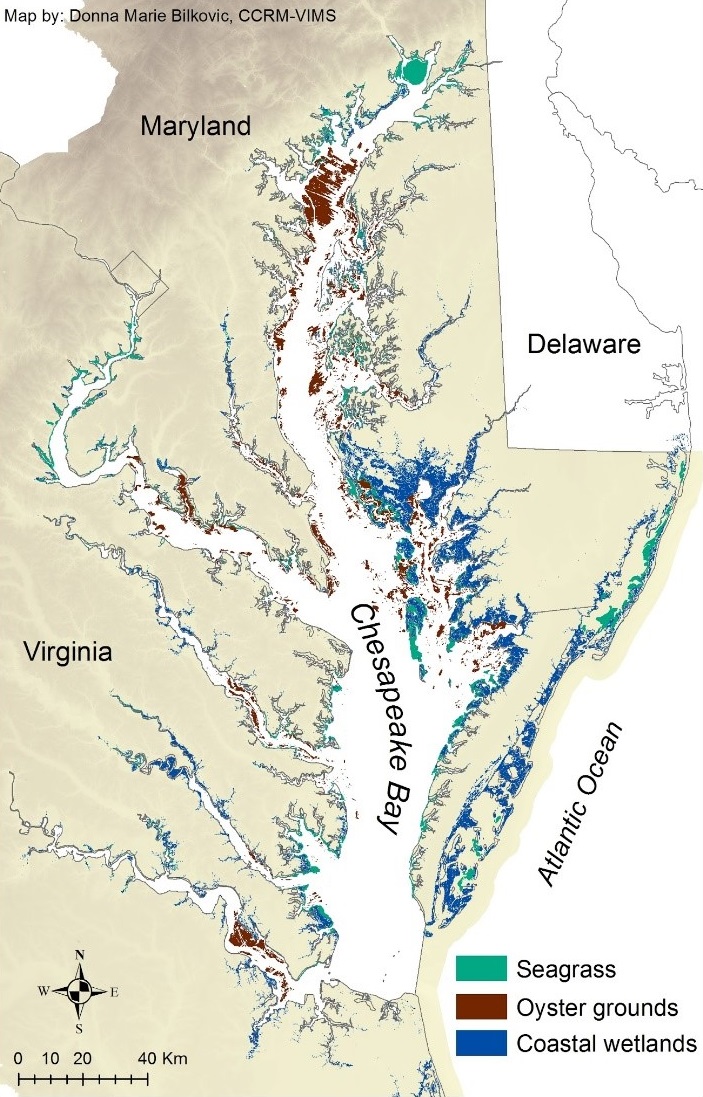Coastal Habitats

As a geologically young drowned-river valley, Chesapeake Bay is a shallow (< 6 m average depth), sheltered estuary with nearly 19,000 km of tidal shoreline. Along its extensive shorelines and within nearshore environments, diverse complexes of habitats contribute to the high productivity of the Bay. Marshes, mud and sand flats, and estuarine beaches populate the intertidal zone, submerged aquatic vegetation occurs within the photic zone of shallow water (typically < 2m depth), and oyster reefs generally occur within subtidal waters (< 8m) with some intertidal reefs occurring near the Bay mouth. In combination, these coastal habitats serve as critical nursery grounds providing protection and feeding grounds for both resident and coastal species from Maine to Florida. The major structural habitats (seagrass beds, marshes, oyster reefs) in the Bay demonstrably support whole marine communities of organisms and are valued, with active programs to restore and protect these features. All of these habitats have diminished drastically from pre-European settlement historic levels and continue to be at risk from human development, climate change, and nutrient pollution.
CCRM Research
Our research on coastal habitats explores numerous topics including the effects of coastal habitat distribution and connectivity on fish and invertebrates, changes in wetlands over time and space from natural and human factors, and quantifying ecosystem service provision of coastal habitat complexes in different shorescapes.
Publications and Products
- Bilkovic, D.M., R.E. Isdell, A.G. Guthrie, M.M. Mitchell, and R.M. Chambers. 2021. Ribbed mussel (Geukensia demissa) population response to living shoreline design and ecosystem development. Coastal and Marine Ecology. (link)
- Bilkovic, D.M., Mitchell, M.M., Havens, K.J. and Hershner, C.H., 2019. Chesapeake Bay. In World Seas: an Environmental Evaluation, Volume I: Europe, The Americas And West Africa, Second Edition, (pp. 379-404). Academic Press, Elsevier Limited. (link)
- Mitchell, J. Herman, D. M. Bilkovic & C. Hershner. 2017. Marsh persistence under sea-level rise is controlled by multiple, geologically variable stressors. Ecosystem Health and Sustainability. http://www.tandfonline.com/doi/full/10.1080/20964129.2017.1396009
- Vulnerability of Coastal habitats in Virginia to climate change - In an early study on the vulnerability of coastal habitats to sea level rise and other climate factors, we estimated that nearly 40% of tidal marshes and 90% of estuarine beaches were at risk from sea level rise because they exist in landscapes that will not allow transgression into the upland, such as residential areas. (link)
- Bilkovic, D.M., M.M. Mitchell, C.H. Hershner, K.J. Havens. 2012. Transitional wetland faunal community characterization and response to precipitation-driven salinity fluctuations. Wetlands 32:425–437.
- Bilkovic, D.M. Response of tidal creek fish communities to dredging and coastal development pressures in a shallow water estuary. Estuaries & Coasts. Volume 34(1):129–147. (pdf)This research was featured in Coastal & Estuarine Science News (CESN, Nov 2010)
- Perry, J., M. Bilkovic, K. Havens, and C. Hershner. 2009. Tidal Freshwater Marshes of the Mid-Atlantic and Southeastern United States. In Tidal Freshwater Wetlands, pp. 157-166. Eds: A. Barendregt, D.F. Whigham, A.H. Baldwin; Backhuys Publishers, Leiden, The Netherlands. (link)
- Horan, J., Bilkovic, N. Gardner, J. Greiner, L. Karrh, K. Sellner, Q. Stubbs. 2014. Designing Sustainable Coastal Habitats. STAC (Chesapeake Bay Program Scientific and Technical Advisory Committee) Publ. #14-003), Edgewater, MD. 74 pp.(pdf)
- Bilkovic, D.M., C.H. Hershner and J.E. Olney. 2002. Macroscale assessment of American shad Spawning and nursery habitats in the Mattaponi and Pamunkey rivers. North American Journal of Fisheries Management 22(4): 1176-1192.(pdf)
- Bilkovic, D.M., J. E. Olney and C. H. Hershner. 2002. Spawning of American shad (Alosa sapidissima) and striped bass (Morone saxatilis) in the Mattaponi and Pamunkey Rivers, Virginia. Fishery Bulletin 100(3): 632-640.(pdf)
